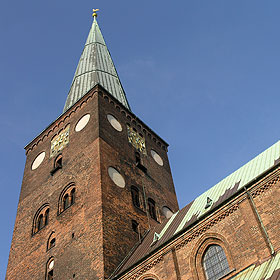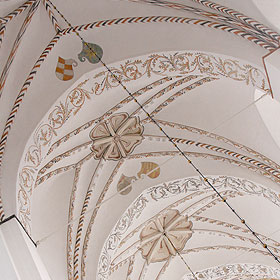


Welcome to the Cathedral of Aarhus
The building of Aarhus Cathedral was started in the last decades of the 12th Century. The exact year is not known for certain. Peter Vognsen of a famous aristocratic family, Hviderne, from Zeeland, was the one, who really got the building going. He was ordained as a Bishop in 1191. The Cathedral – a magnificent Romanesque basilica – was a gigantic project, not finished until about 1350. Red bricks were used, a kind of material not otherwise used in Denmark before approx. 1160. The outer walls of this Cathedral and the beautiful chapels along the eastern wall of the transept are the only surviving Romanesque elements today.
The Cathedral, as it otherwise stands today, is the result of radical rebuilding in the Gothic style, undertaken from 1449 till about 1500, transforming the heavy and sombre building into a Gothic cathedral, inspired by the great contemporary churches in the Hanseatic towns around the Baltic Sea. Considerable height completed with cross- and star vaulting was added to the nave as well as to the aisles and the transept. The culmination however was the altogether reconstructed and enlarged chancel, now with three naves of the same height, an ambulatory and 13 high, pointed windows throwing cascades of light into this bright space.
With a length of 93 metres Aarhus Cathedral is the longest church in Denmark, and it seats approx. 1200 people. From the beginning it was dedicated to St Clement, the patron saint of sailors.
The Frescoes
The frescoes were all made between 1470 and 1520, except the one surrounding the socalled leprosy window in the northwest corner of the Cathedral. It was painted in about 1300, and it is the oldest piece of art in the cathedral, the only one left from the Romanesque church.
The Font
Bishop Jens Iversen Lange, who had already donated a magnificent new altarpiece, two years earlier, donated it. The font has the form of a truncated cone, and it rests on the four Evangelists. These are extraordinary figures – retaining their human bodies, but crowned with symbolic animal heads: St John with an eagles head, St Mark a lions head and St Luke with the head of an ox.
In a Gothic framework 4 scenes are depicted: The Baptism, the Crucifixion, Christ on the Day of Judgement and the Coronation of Mary. Between these scenes nine apostles are depicted, standing on small corbels. It is possible to identify Peter with his key, the young John, James the Elder with a pilgrim’s insignia, Thomas with a set square and Bartholomew with his skin hanging over his arm. The identity of the rest is uncertain.
During the first two centuries the font was open, the priest baptizing the infants by immersing them three times in the water. The font is now covered by a brass dish, and at christenings by a three hundred-year old silver dish.
The Pulpit
In the latter, the apostles are depicted as individuals, vigorously moving their heads on long, sinewy necks. According to custom St John is sitting on Jesus’ lap as a child. More remarkably, Judas is very originally conceived: Usually he is shown isolated from the other apostles with an evil and dark expression, but here he is part of the fellowship, easily recognizable by the purse in his hand. He is seen closest to the viewer, halfway turning his back.
In the last reliefs you see the Crucifixion, the Resurrection, Pentecost, and finally the Day of Judgement.
Golden Portals
The Cathedral has five very fine wrought-iron latticework portals, which are all made by the German master smith Caspar Fincke. His mark, a hammer and a key laid across one another, is usually seen in a corner of one of the large panels composing the portals. The most remarkable of Caspar Fincke’s works is the golden portal leading up to the chancel. It consists of four panels with circles and quadrangles. The quadrangle is the symbol of humans, and the circle, being both rounded and indefinite, is the symbol of Heaven.
The Votive Ship
The Altar
From 1975-81 the altar-piece underwent a thorough restoration at the conservation department of the Danish National Museum at Brede. Layers of old varnish and lacquer were removed and the golden panels were polished up with tiny cotton sticks. The Feastday panels now appear in their original form, the way they were delivered to St Clement’s Cathedral in 1479.
Prior to their most recent restoration, the rear-side panels were just a large surface painted in brown, but new examination techniques revealed exciting motifs which have now been uncovered.
The Feast day panels are carved work. All the figures are coated with 23.5-carat gold. The large centre panel depicts the patron saint of the town and the Cathedral, St Clement, and opposite him St John the Baptist, the patron saint of Bishop Jens Iversen Lange, the donor of the altarpiece. In the middle we see Mary and her mother, St Anna, holding the Infant Jesus. The two side panels portray the twelve Apostles with their appropriate symbols. The top cupboard depicts the Coronation of Mary in Heaven, surrounded by the two Archangels: Gabriel, the herald of the good, and Michael as a dragon killer, the extirpator of evil. The predallas below depict the Gregorian Mass and Christ as the Mediator on the Day of Judgment.
The organs
In 1927-29 Theodor Frobenius rebuilt the organ extensively and the number of stops was increased to 84 with four manuals and a pedal keyboard. Kastens’ magnificent facade and a number of the old stops were preserved. The organ kept its mechanical wind chest tables, but playing it was facilitated by means of a complex, pneumatic intermediate link. Some minor changes were made in the 1940s, but in 1958 the next major restoration took place, at which time the instrument obtained its “Baroque” character with a noble, slightly treble sound. Frobenius’ original French reed stops were shortened in order to give them a clearer sound.
In 1981-83 new winds were blowing again, and a successful attempt was made to restore the organ to its symphonic sound of 1927, without jeopardizing the clarity of sound obtained in 1958. In 1993 the pneumatic intermediate link was removed, and instead electromagnets electromagnets that could pull the bellows were mounted. This has provided the organ with an optimum degree of precision. At the same time the organ was fitted with a system of electronic stops, a Setzer with 3 x 256 combinations. The organ now has 89 stops distributed on four manuals (great organ, positive, swell organ, crown positive) and pedal keyboard, and is thus the largest organ in Denmark.
In view of the length and the acoustics of the Cathedral, it was decided in the 1960s to build another organ, that was to be used for weddings and other services (and concerts) taking place in the chancel. Bruno Christensen & Sons built the organ in 1970, and it is a typical example of a Neo-Baroque instrument. The organ has 23 stops distributed on great organ manual, swell organ manual, and pedal keyboard. It is mounted in the southern side of the chancel.
